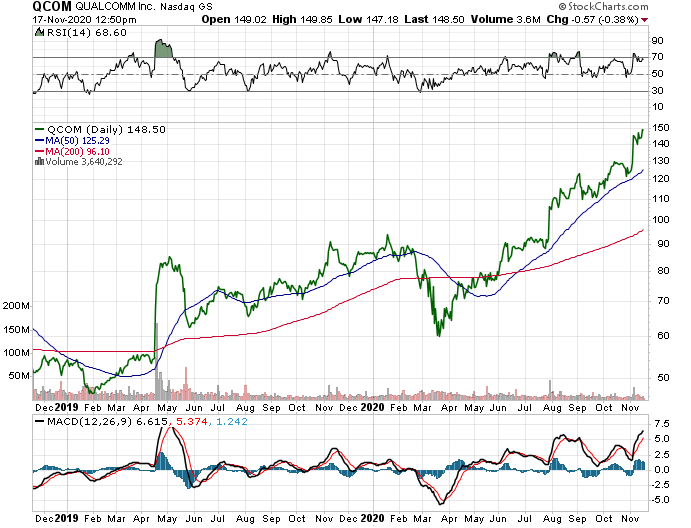Qualcomm, Inc.: 5G Giant Hits Record Highs on Earnings Beat & Supply Agreement
Marijuana Business, Stocks, Finance, & Investing November 25, 2020 MJ Shareholders 0

 Qualcomm, Inc. Shares Trounce Market, Up 68% in 2020
Qualcomm, Inc. Shares Trounce Market, Up 68% in 2020
Qualcomm, Inc. (NASDAQ:QCOM) stock has been on a tear since the start of 2019, rising 153%. Qualcomm stock is also up 69% year-over-year, 68% year-to-date, and 158% since bottoming in March.
There are a few reasons why QCOM stock has been trouncing the broader market.
For starters, back in April 2019, the company announced a settlement with Apple Inc (NASDAQ:AAPL) over patent royalties. News of the settlement sent Qualcomm stock soaring more than 50%. Barring the coronavirus-driven sell-off in March 2020, QCOM stock has been advancing since then.
Qualcomm stock also recently jumped following the release of strong 5G-fueled earnings results in November that topped Wall Street expectations.
Also in November, Qualcomm received a license to sell some of its 4G chips to Huawei Technologies Co., Ltd.
Furthermore, back in 2019, the company’s venture capital arm, Qualcomm Ventures, announced it was investing in four new companies that advance 5G technology.
Chart courtesy of StockCharts.com
QCOM Stock Overview
Qualcomm has been a leader in 3G, 4G, and now 5G technologies. The San Diego-based company is a global leader in the development and commercialization of foundational technologies from network equipment, to broadband gateway equipment, to consumer electronic devices. (Source: “2019 Analyst Day,” Qualcomm, Inc., November 19, 2019.)
The company’s integrated circuits and systems software are used in mobile devices, wireless networks, the Internet of Things (IoT), broadband gateway equipment, consumer electronic devices, automotive telematics systems, and automotive infotainment systems.
As Qualcomm’s technology grows and evolves, the company expects to maintain its position as a market leader in the mobile communications industry, especially in 5G wireless technology.
Investment in Four New 5G Companies
In 2019, Qualcomm, Inc. announced the Qualcomm Venture 5G Ecosystem Fund, a $200.0-million investment program designed to help companies develop innovative 5G technologies. (Source: “Accelerating the 5G Revolution,” Qualcomm Ventures, November 11, 2020.)
To that end, Qualcomm Venture announced it was investing in four new 5G companies:
- Celona Inc, a Cupertino, CA-based company that has developed wireless architecture for deploying private 5G networks
- Cellwize, an Israeli company that targets large and growing 5G infrastructure automation
- Azion Technologies LLC., a Brazil-based company that focuses on edge computing, which is a key technology that supports 5G
- Pensando Systems, a Bay Area-based company that builds an integrated platform for powering software-defined cloud, networking, storage, and security services with minimal latency and low power requirements
Permission to sell 4G Chips to Huawei
On November 13, Qualcomm, Inc. said it received a license from the U.S. government to sell 4G mobile phone chips to Huawei. This license is an exemption to a ban that the U.S. government implemented in September. (Source: “Qualcomm Receives U.S. Permission to Sell 4G Chips to Huawei in Exception to Ban,” Reuters, November 14, 2020.)
Under the ban, Qualcomm and other semiconductor companies had been forced to stop selling their products to the Chinese phone juggernaut.
Qualcomm did not say which 4G products it would be selling to Huawei, but it confirmed that they’re related to mobile devices. Qualcomm has other license applications pending with the U.S. government.
Huawei is a relatively small customer for Qualcomm, using the company’s chips mainly for lower-priced models.
While the new license will have a limited impact on Qualcomm’s finances, since it only covers 4G chips at a time when the world is shifting to 5G, it’s a positive sign for the company. It possibly opens the door for Qualcomm to also be allowed to sell its 5G smartphone chips to Huawei at some point.
Strong Fourth-Quarter Results
On November 4, Qualcomm announced that its revenue for the fourth quarter of fiscal 2020, ended September 27, increased 75% year-over-year to $8.3 billion. Its adjusted revenue was up 35%, at $6.5 billion. Analysts had been expecting adjusted revenue of $5.9 billion. (Source: “Qualcomm Announces Fourth Quarter and Fiscal 2020 Results,” Qualcomm, Inc., November 4, 2020.)
The company reported fourth-quarter net income of $3.0 billion ($2.58 per share), up from fourth-quarter 2019 net income of $506.0 million ($0.42 per share).
Adjusted net income was $1.7 billion ($1.45 per share), a 76% increase over the fourth-quarter 2019 net income of $947.0 million ($0.78 per share). Wall Street had forecast adjusted earnings per share of $1.17.
Qualcomm, Inc. said it’s well placed to benefit from the rise of 5G networks and handsets. One of its 5G chips is in Apple’s “iPhone 12.” It’s thought that Qualcomm’s revenue from Apple during the fourth quarter was limited, which suggests serious upside in 2021.
The company also said it expects about 200 million 5G smartphones to be shipped in 2020 and 500 million to be shipped in 2021. While Qualcomm does not make smartphones, it does sell products to other companies that make smartphones.
To that end, Qualcomm said it expects to report “high single digit growth” in smartphone shipments—which includes 5G, 4G, and 3G phones—in 2021.
For the first quarter of fiscal 2021, Qualcomm expects to report revenue between $7.8 and $8.6 billion, and adjusted earnings per share between $1.95 and $2.15.
Analyst Take
5G giant Qualcomm, Inc. reported strong fourth-quarter results and impressive guidance.
The company’s 5G technology is starting to take off, with growth projections expected to follow suit. Moreover, the impact of future sales to Apple (and potential 5G sales to companies like Huawei) should juice revenue and boost the value of Qualcomm stock.
MJ Shareholders
MJShareholders.com is the largest dedicated financial network and leading corporate communications firm serving the legal cannabis industry. Our network aims to connect public marijuana companies with these focused cannabis audiences across the US and Canada that are critical for growth: Short and long term cannabis investors Active funding sources Mainstream media Business leaders Cannabis consumers











No comments so far.
Be first to leave comment below.